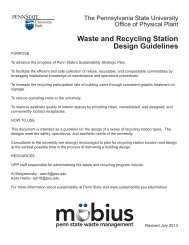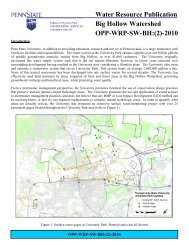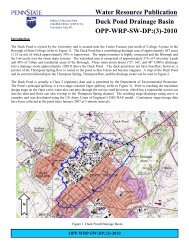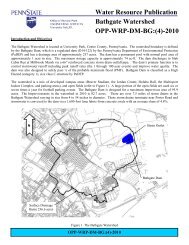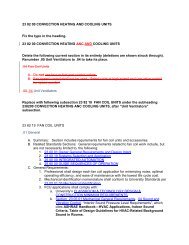Utility Fact Sheet - Office of Physical Plant - Penn State University
Utility Fact Sheet - Office of Physical Plant - Penn State University
Utility Fact Sheet - Office of Physical Plant - Penn State University
You also want an ePaper? Increase the reach of your titles
YUMPU automatically turns print PDFs into web optimized ePapers that Google loves.
Steam Boiler <strong>Plant</strong>s:<br />
Steam is generated at high pressure (250 psi) from coal-fired and gas-fired boilers at two locations. Low-pressure steam<br />
is generated by steam turbines in the West Campus Steam <strong>Plant</strong>. The turbines utilize high-pressure steam as a power<br />
source and are set to exhaust at 13 psi. Summer plant operation yields a typical load <strong>of</strong> 100,000 lbs/hr @ 250 psi. A<br />
typical winter operation yields an average load <strong>of</strong> 350,000 lbs/hr @ 250 psi. In each case, approximately 50% <strong>of</strong> the<br />
steam generated is delivered to campus at 170 psi, after being reduced at the West Campus Steam <strong>Plant</strong>, and 50% <strong>of</strong> the<br />
steam generated is delivered to campus at 13 psi. The peak load on the steam plants to date <strong>of</strong> approximately 431,300<br />
lbs/hr occurred on 02/06/2007 when air temperatures approached 0°F for approximately one hour.<br />
Peak steam load served during FY09/10:<br />
368,300 lbs/hr<br />
Peak steam during FY09/10 occurred on: 01/29/2010<br />
Total steam production for FY09/10:<br />
1,339,463,954 lbs<br />
Steam Generation Steam Flow, kpph PSI/ºF BTU/Lb Firm Capacity*<br />
WCSP Type Name Plate Proven minus 1 WCSP Boiler minus 1 ECSP Boiler<br />
Boiler 1 Coal 110,000 90,000 250/530 1,290 - 87,500<br />
Boiler 2 Coal 110,000 90,000 250/530 1,290 90,000 87,500<br />
Boiler 6 Coal 120,000 90,000 250/530 1,290 90,000 87,500<br />
Boiler 8 Coal 110,000 90,000 250/530 1,290 90,000 87,500<br />
Boiler 5 Gas 75,000 45,000 250/530 1,290 - -<br />
525,000 405,000 270,000 350,000<br />
ECSP<br />
Boiler 1 Gas/Oil 100,000 75,000 250/406 1,202 75,000 -<br />
Boiler 2 Gas/Oil 100,000 75,000 250/406 1,202 75,000 75,000<br />
200,000 150,000 150,000 75,000<br />
725,000 555,000 420,000 425,000<br />
* The Firm Capacity, by definition, is the total with the largest boiler <strong>of</strong>f-line. Boiler 5 has been deemed unreliable<br />
and is therefore excluded from the Firm Capacity Calculation<br />
** The coal boilers are also limited by their permitted capacity to 350,000 #/hr.<br />
Electricity Generation Qty. Capacity/Type<br />
Psi / ºF Psi / ºF<br />
in out<br />
Btu/Lb.<br />
West Campus Steam <strong>Plant</strong> 1 2500 kw / Steam Turbine 250/530 13/246 1162<br />
West Campus Steam <strong>Plant</strong> 1 3500 kw / Steam Turbine 250/530 13/246 1162<br />
East Campus Steam <strong>Plant</strong> 0<br />
Peak Output<br />
<strong>Utility</strong> <strong>Fact</strong> <strong>Sheet</strong><br />
<strong>University</strong> Park Campus<br />
OPP-UFS-UP: 2010<br />
4,500 kw<br />
Average Summer Output*<br />
1,200 kw<br />
The electric output <strong>of</strong> the turbines is limited by the need for low-pressure steam or limitations in<br />
our heating equipment to utilize low-pressure steam and not by the production capacity <strong>of</strong> the turbines.<br />
The following events <strong>of</strong> significance occurred during FY09/10 at the Steam Boiler <strong>Plant</strong>s:<br />
Project continues to install a natural gas combustion turbine with a heat recovery steam boiler at the<br />
East Campus Steam <strong>Plant</strong> to co-generate 100,000 pph <strong>of</strong> steam and 7MW <strong>of</strong> electricity.<br />
OPP-UFS-UP:2010 1
<strong>Penn</strong> <strong>State</strong> <strong>University</strong><br />
<strong>Utility</strong> <strong>Fact</strong> <strong>Sheet</strong><br />
Steam Distribution:<br />
Steam consumption is by 250, 170 and 13-psi distribution systems. The 250-psi system is used to drive the turbine<br />
generators that produce the 13-psi steam while also co-generating electricity. Steam driven turbine feed water pumps,<br />
induced draft fans and forced draft fans are used in the boiler plant at 250 psi and also exhaust at 13 psi. The 170-psi<br />
system is used for process and heating loads throughout the campus. Process loads include lab use, sterilizers, distilled<br />
water, laundry, dining hall use, etc. For heating purposes, this steam is reduced to low pressure at the individual<br />
buildings. The 13-psi system is used for space heating, domestic hot water and absorption chillers throughout the campus.<br />
Due to system use and losses, the 13-psi system only delivers about 5 to 8 psi to the buildings during heavy load<br />
conditions in the winter months.<br />
Steam Condensate System:<br />
The steam condensate is gathered at the individual building level by a gravity return system to a building condensate<br />
pump. The building pump pushes the condensate into the campus return system. Most <strong>of</strong> the North and East areas <strong>of</strong><br />
campus flow by gravity to the East View Condensate Pumping Station. From there the condensate is pumped to the West<br />
Campus Steam <strong>Plant</strong>. The Central campus area flows by gravity to Hammond Building, where it is pumped to the West<br />
Campus Steam <strong>Plant</strong>. The West campus is returned to the West Campus Steam <strong>Plant</strong> via a vacuum assisted pump. No<br />
condensate is returned to the East Campus Steam <strong>Plant</strong>. Average return rate is 75%.<br />
Stack Emissions Control:<br />
A bag house filtration system is installed on the flue gas from the coal boilers to comply with the Department <strong>of</strong><br />
Environmental Protection Standards. There are 2,112 gore-tex filter bags installed in eleven compartments designed to<br />
handle the 350,000 #/hr permitted capacity <strong>of</strong> the coal boilers. During FY05/06 the gore-tex filter bags were replaced for<br />
the first time since the initial baghouse installation in 1986.<br />
Other Power <strong>Plant</strong> Services Provided:<br />
Control air to main campus (Lab Quality): 3,000 SCFM @ 70 psi with a duty, standby and emergency compressor<br />
located at each steam boiler plant. (East Campus <strong>Plant</strong> & West Campus <strong>Plant</strong>)<br />
Campus Electrical System:<br />
Electricity for the Campus is supplied through five sub-stations by Allegheny Power at 12,470 volts. Each sub-station has<br />
two dedicated feeders installed. The maximum demand for the campus in FY09/10 was approximately 51.1 MW.<br />
Substation ID Voltage # Feeders Available Capacity<br />
1* 12,470 2 @ 20 MW Auto switched, 20 MW total<br />
2 12,470 2 @ 20 MW Manual switched, 20 MW total<br />
3* 12,470 2 @ 13 MW Auto-switched, 13 MW total<br />
4 12,470 2 @ 20 MW Manual switched, 20 MW total<br />
5 12,470 2 @ 20 MW Auto-switched, 20 MW total<br />
Steam Turbine 4,160 N/E<br />
Steam Turbine 4,160 N/E<br />
4.5 MW<br />
Total<br />
87 MW**<br />
*26 MW total<br />
** The steam turbines may be used to shed load from the utility and therefore 3.5 MW<br />
are not added to the total available capacity.<br />
Electrical Distribution System:<br />
Electricity is distributed around campus at 12,470 volts and at 4,160 volts for normal power. 22.5 MW <strong>of</strong> installed<br />
transformers reduce portions <strong>of</strong> the 12,470 volts to 4,160 volts for distribution. The emergency power system is<br />
distributed at 4,160 volts to limited number <strong>of</strong> facilities. All new facilities as well as renovated facilities with significant<br />
additional loads are served from the 12,470 volt distribution system. The steam turbines at the West Campus Steam <strong>Plant</strong><br />
generate power at 4160 volts and operate in parallel with the utility power or in island mode if utility power is not<br />
available. One <strong>of</strong> the circuits from this bus provides power for the emergency (Life Safety) grid on campus. Automatic<br />
transfer switches at each building sense normal power and determine when to transfer the building load from the normal<br />
feeder to the emergency feeder when normal power is lost. Some buildings have a traditional emergency generator<br />
OPP-UFS-UP:2010 2
<strong>Penn</strong> <strong>State</strong> <strong>University</strong><br />
<strong>Utility</strong> <strong>Fact</strong> <strong>Sheet</strong><br />
installed in lieu <strong>of</strong> having a connection to the campus emergency circuit. A second circuit provides power to the standby<br />
grid on campus. The standby grid serves critical research and legally required non life safety backup power via transfer<br />
switching in buildings.<br />
The following modifications were made to the electrical distribution system during FY09/10 to improve reliability and/or<br />
increase capacity:<br />
Increased capacity at Ag Hill substation from 13 MW to 27 MW. Installed / replaced electro-mechanical<br />
protective relays in Ag-Hill substation.<br />
Chilled Water System:<br />
A campus chilled water distribution system is relatively new compared with the other utility systems. The system has<br />
three chilled water production facilities connected to the distribution loop. The total system capacity when completed will<br />
be approximately 40,000 tons and will include an East Campus Chiller <strong>Plant</strong>, which is not yet into design.<br />
Many <strong>of</strong> the existing buildings still have their own chillers installed. An eventual connection to the campus distribution<br />
system will be made as selected building chiller plants are retired. There are approximately 135 air or water cooled<br />
chillers installed and maintained at <strong>University</strong> Park for process and air conditioning purposes ranging in size from a few<br />
tons to 1000 tons. These chillers represent approximately 25,000 tons <strong>of</strong> installed capacity. A second expansion <strong>of</strong> the<br />
North Campus Chiller <strong>Plant</strong> was recently completed to bring the total number <strong>of</strong> chillers in the North <strong>Plant</strong> to 6.<br />
Modifications to the West Campus Chiller <strong>Plant</strong> are also planned, as well as additional underground distribution piping.<br />
The following chiller plants are connected to the central distribution system:<br />
CHW Generation<br />
Capacity<br />
<strong>Plant</strong> Energy Source Type Refrigerant Tons<br />
NCCP - North Campus Chiller <strong>Plant</strong>*<br />
Chiller 1 Electric Centrifugal R134a 1,500<br />
Chiller 2 Electric Centrifugal R134a 1,500<br />
Chiller 3 Electric Centrifugal R134a 1,300<br />
Chiller 4 Electric Centrifugal R134a 1,300<br />
Chiller 5 Electric Centrifugal R134a 1,500<br />
Chiller 6 Electric Centrifugal R134a 1,500<br />
CHCP - Chemistry Chiller <strong>Plant</strong><br />
Chiller 1 Electric Centrifugal R134a 1,350<br />
Chiller 2 Electric Centrifugal R134a 1,350<br />
Chiller 3 Electric Centrifugal R134a 1,350<br />
WCCP - West Campus Chiller <strong>Plant</strong>**<br />
Chiller 1 Electric Centrifugal R123 1,000<br />
Chiller 2 Electric Centrifugal R123 1,000<br />
Total Capacity 14,450<br />
The North Campus Chiller <strong>Plant</strong> has a potential future capacity <strong>of</strong> 11,600 tons.<br />
** The West Campus Chiller <strong>Plant</strong> has a potential future capacity <strong>of</strong> 12,000 tons.<br />
Chilled Water Distribution:<br />
Underground chilled water piping has been installed under the main road corridors that intersect campus including:<br />
Pollock Road, Shortlidge Road, Curtin Road, Burrowes Road. Piping has also been installed from the West Campus<br />
Chiller <strong>Plant</strong> across Atherton Street. During FY06/07 loop additions were designed and installation was initiated in<br />
several areas. A branch was added to serve Reber, Hintz Alumni Center, EE East, EE West, and Deike. This branch is<br />
designed to serve Hammond, Sackett, Hosler, and Steidle in the future. The branch serving Davey and Osmond was<br />
extended to Chandlee. A branch was added along Bigler Road, under Park Avenue to serve the new Katz Building. A<br />
branch was added to serve Wartik, with future capacity for Althouse, Pond and others. The extension <strong>of</strong> the main was<br />
OPP-UFS-UP:2010 3
<strong>Penn</strong> <strong>State</strong> <strong>University</strong><br />
<strong>Utility</strong> <strong>Fact</strong> <strong>Sheet</strong><br />
added in the northwest corner <strong>of</strong> campus in summer <strong>of</strong> 2009 that connected Arts Building, Cedar Building, and Keller<br />
Building, with provisions to connect the new Child Daycare facility and the Moore Building Addition. These new mains<br />
will have the capacity to serve all existing buildings in this area in the future, including Ford, Rackley, Mateer, Chambers,<br />
Kern, and Carpenter Buildings.<br />
As <strong>of</strong> October 2010, the Campus Chilled Water System serves a total <strong>of</strong> 3.6 million square feet in 52 buildings; an<br />
estimated peak cooling load <strong>of</strong> approximately 10,000 tons.<br />
Natural Gas System<br />
Natural Gas is distributed around the campus by an underground system <strong>of</strong> direct buried, coated steel pipes. Columbia<br />
Gas owns some <strong>of</strong> the piping and all <strong>of</strong> the billing meters, while the <strong>University</strong> owns some <strong>of</strong> the piping and some submeters<br />
for billing within the <strong>University</strong> family. The majority <strong>of</strong> the <strong>University</strong> owned lines are at 5 psi, with the exception<br />
<strong>of</strong> some high-pressure gas lines on West Campus and near <strong>Physical</strong> <strong>Plant</strong> on the Northern part <strong>of</strong> campus. All <strong>of</strong> the<br />
Columbia Gas owned lines are at 25 psi or higher.<br />
Water System<br />
The potable water system on the <strong>University</strong> Park Campus is owned and operated by the <strong>University</strong>. There are seven<br />
production wells currently in service in two well fields; each well field is capable <strong>of</strong> supplying the <strong>University</strong>’s needs. The<br />
<strong>University</strong> uses almost three million gallons <strong>of</strong> water per day. Four above ground water storage tanks have a storage<br />
capacity <strong>of</strong> 3,750,000 gallons, which is over a day’s supply. Treatment and monitoring is provided for all wells to insure<br />
that water delivered to customers meets all regulatory requirements. Several connections with the <strong>State</strong> College Water<br />
Authority (SCBWA) are maintained where water can be exchanged. An additional emergency connection is maintained<br />
with another Municipal Water Authority which the <strong>University</strong> could supply water.<br />
<strong>University</strong> Park has two main well fields: Big Hollow and Houserville. The Big Hollow Well Field has six permitted<br />
production wells: UN2, UN14, UN16, UN17, UN24, & UN26, <strong>of</strong> which four wells are currently in use. The Houserville<br />
Well Field has three permitted production wells: UN33, UN34, & UN35, <strong>of</strong> which all three wells are currently in use. An<br />
additional permitted production well is UN28A, which is not in use. The wells have the following permitted capacities:<br />
Big Hollow gpm mgd Year Drill<br />
UN 2 400 0.576 1938<br />
UN 14 720 1.037 1948<br />
UN 16 250 0.360 1948<br />
UN 17 400 0.576 1949<br />
UN 24 450 0.648 1962<br />
UN 26 800 1.152 1965<br />
Total 3,020 4.349<br />
Houserville gpm mgd Year Drill<br />
UN 33 1,200 1.728 1981<br />
UN 34 1,200 1.728 1981<br />
UN35 1,200 1.728 1984<br />
Total 3,600 5.184<br />
Well UN28A has a capacity <strong>of</strong> 300 gpm or 0.432 mgd (year drill – 1974). <strong>University</strong> Park’s total well fields’ production<br />
capacity is 6,920 gpm or 9.965 mgd.<br />
Geology and Hydrogeology<br />
Both the Big Hollow and Houserville Well Fields are located in karst limestone terrain. The region’s land surface<br />
contains many sinkholes, caves are common, and surface drainage is minimal. Big Hollow wells are installed in the<br />
Cambrian Gatesburg Formation. Houserville wells are over the Ordovician Nittany and Axeman Formations. The wells<br />
in both fields have relative high yields for the consolidated formations they are sited.<br />
OPP-UFS-UP:2010 4
<strong>Penn</strong> <strong>State</strong> <strong>University</strong><br />
<strong>Utility</strong> <strong>Fact</strong> <strong>Sheet</strong><br />
Water Quality<br />
Both the Big Hollow and Houserville Well Fields’ water is hard; Big Hollows water’s hardness ranges from 150 to 200<br />
mg/l as CaCO 3 , and Houserville water’s hardness ranges from 300 to 350 mg/l as CaCO 3 . The water is high in alkalinity<br />
and total dissolved solids from the dissolved mineral content. Fifty water quality samples are collected and analyzed each<br />
month from the distribution system. The treated water meets both primary and secondary US EPA drinking water<br />
standards. An annual water quality report is prepared each year in June, which is referred to as Consumer Confidence<br />
Report (CCR). The 2009 CCR is post on the <strong>Office</strong> <strong>of</strong> <strong>Physical</strong> <strong>Plant</strong>’s web site at http://www.opp.psu.edu/aboutopp/2009-drinking-water-quality-report.<br />
Water Treatment<br />
Water Treatment Facilities for <strong>University</strong> Park’s potable water include Chlorine House #1, Chlorine House #2, Chlorine<br />
House #3 (inactivate), Chlorine House #4 (inactivate), Chlorine House #5, and the Water Treatment <strong>Plant</strong>.<br />
Chlorine House #1 is in Big Hollow. It typically treats the water from Wells UN16, UN17, & UN26, but has the able to<br />
treat the other wells in Big Hollow. The treatment consists <strong>of</strong> flow monitoring, chemical addition <strong>of</strong> a sequestering agent<br />
(phosphate compound), and chlorination for disinfection. Three underground baffled tanks provide hydraulic retention<br />
time for proper disinfection. Chlorine House #1 is a regulated entry point to the distribution system. A continuous<br />
chlorine analyzer monitors the free residual chlorine in the treated water.<br />
Chlorine House #2 is in Big Hollow. There are two parallel treatment trains, one for “finished water” and the other for<br />
“raw water”. The finished water train typically treats the water from Well UN24, but has the able to treat the other wells<br />
in Big Hollow. The treatment consists <strong>of</strong> flow monitoring, chemical addition <strong>of</strong> a sequestering agent (phosphate<br />
compound), and chlorination for disinfection. Two underground baffled tanks provide hydraulic retention time for proper<br />
disinfection. Chlorine House #2 is a regulated entry point to the distribution system. A continuous chlorine analyzer<br />
monitors the free residual chlorine in the treated water. The raw water train is for future use. It was designed and built to<br />
pretreat all <strong>of</strong> the Big Hollow Wells prior to flowing to the water treatment plant. The treatment will consist <strong>of</strong> flow<br />
monitoring, chemical addition <strong>of</strong> a sequestering agent (phosphate compound), and chlorination for disinfection. A<br />
continuous chlorine analyzer will monitor the free residual chlorine in the pretreated water.<br />
Chlorine House #3 is on the Golf Course. The facility is inactive. It treated the water from Well UN28A. The treatment<br />
consisted <strong>of</strong> flow monitoring, chemical addition <strong>of</strong> a sequestering agent (phosphate compound), and chlorination for<br />
disinfection.<br />
Chlorine House #4 is at the West Campus Steam <strong>Plant</strong>. The facility is inactive. It treated the water from Well UN12.<br />
The treatment consisted <strong>of</strong> flow monitoring, chemical addition <strong>of</strong> a sequestering agent (phosphate compound), and<br />
chlorination for disinfection.<br />
Chlorine House # 5 is in Houserville. It pretreats the water from Wells UN33, UN34, & UN35. The pretreatment consists<br />
<strong>of</strong> flow monitoring, chemical addition <strong>of</strong> a sequestering agent (phosphate compound), and chlorination for disinfection.<br />
A continuous chlorine analyzer monitors the free residual chlorine in the treated water. The pretreated water is conveyed<br />
to the Water Treatment <strong>Plant</strong> for additional treatment.<br />
Water Treatment <strong>Plant</strong> (WTP) is located north <strong>of</strong> the <strong>Physical</strong> <strong>Plant</strong> Building. Currently the facility treats water from<br />
Chlorine House #5, which serves Houserville. Raw water line is in place to convey water from Big Hollow through<br />
Chlorine House #2 to the WTP. The treatment process consists <strong>of</strong> two air stripping towers operated in parallel followed<br />
by chlorine disinfection and retention in a clear well. Water is pumped from the clear well into the distribution system.<br />
The WTP is a regulated entry point to the distribution system. A continuous chlorine analyzer monitors the free residual<br />
chlorine in the treated water.<br />
Water Distribution System<br />
<strong>University</strong> Park’s potable (drinking) water system consists <strong>of</strong> over 26 miles <strong>of</strong> pipe. The majority <strong>of</strong> our distribution<br />
system’s piping is constructed <strong>of</strong> ductile iron. Four elevated storage tanks in the distribution system provide reserve<br />
storage capacity and fire protection for <strong>University</strong> Park.<br />
OPP-UFS-UP:2010 5
<strong>Penn</strong> <strong>State</strong> <strong>University</strong><br />
<strong>Utility</strong> <strong>Fact</strong> <strong>Sheet</strong><br />
Water Storage<br />
<strong>University</strong> Park’s potable water system has four elevated storage tanks. Water Tower #1 is located near the Nittany Lion<br />
Inn. It was erected in 1937 and has a storage capacity <strong>of</strong> 500,000 gallons. Water Tower #2 is located near the North<br />
Halls. It was erected in 1956 and has a storage capacity <strong>of</strong> 750,000 gallons. Water Tower #3 is located north <strong>of</strong> the<br />
<strong>Physical</strong> <strong>Plant</strong> Building. It was erected in 1962 and has a storage capacity <strong>of</strong> 1,000,000 gallons. Water Tower #4 is<br />
located on the Golf Course. It was erected in 1992 and has a storage capacity <strong>of</strong> 1,500,000 gallons.<br />
Sanitary System<br />
A campus sanitary system is owned and operated by the <strong>University</strong>. The wastewater treatment plant is located on<br />
<strong>University</strong> Drive near Route 26. The plant currently operates at over 2 million gallons/average day. Included in the<br />
current daily throughput is about 500,000 gpd taken from the Borough <strong>of</strong> <strong>State</strong> College for a fee. None <strong>of</strong> the effluent is<br />
wasted to nearby Spring Creek; instead it is pumped to spray irrigation fields after being treated. Some parts on the north<br />
side <strong>of</strong> campus utilize a local sanitary system owned by the <strong>University</strong> Area Joint Authority on a fee for service basis.<br />
Storm System<br />
The <strong>University</strong> Park Storm Drain System is currently a 100% gravity flow system consisting <strong>of</strong> approximately 66 linear<br />
miles <strong>of</strong> storm drain pipes varying from 4 inches to 66 inches in diameter, and thousands <strong>of</strong> inlets and manholes. The<br />
<strong>University</strong> has varying levels <strong>of</strong> documentation for the entire system including approximately 1/2 <strong>of</strong> which is precisely<br />
surveyed. The <strong>University</strong> owns large tracts <strong>of</strong> land in the Centre Region tributary to the Big Hollow (Chpt. 93, CWF),<br />
Shavers Creek (Chpt. 93, HQ-CWF), Thompson Run (Chpt. 93, HQ-CWF), Spruce Creek (Chpt. 93, HQ-CWF), Slab<br />
Cabin Run (Chpt. 93, CWF sections), and the main stem <strong>of</strong> Spring Creek (Chpt. 93, HQ-CWF).<br />
The main campus portion <strong>of</strong> <strong>University</strong> Park is comprised <strong>of</strong> four primary drainage basins and several smaller drainage<br />
areas. The four are: 1) the Fox Hollow Drainage Basin, 2) the Bathgate Dam Basin, 3) the Main Campus Basin, and 4)<br />
the West Campus Drainage Basin. The Fox Hollow and West Campus Drainage Basins are tributary to the Big Hollow,<br />
the Bathgate Dam Basin is tributary to Slab Cabin Run, and the Main Campus Basin is tributary to Thompson Run.<br />
Examples <strong>of</strong> the smaller basins include the Foods Building Detention Pond, the Parking Lot 43 Detention Pond, the Corl<br />
Drywell, Cato Park Pond, and the Grad Circle Parking Bio-swales.<br />
Peak run<strong>of</strong>f rate control, volume control, and water quality control are conducted in the <strong>University</strong> Park area to varying<br />
degrees in each <strong>of</strong> the four Basins. While minor structural stormwater management systems exist in each <strong>of</strong> the basins<br />
that were developed for specific land development projects, major systems have also been constructed to function at the<br />
basin scale. The Fox Hollow and West Campus Basins both are considered to effectively control peak run<strong>of</strong>f rates,<br />
volume, and water quality. The Bathgate Dam basin is considered to effectively control peak run<strong>of</strong>f rates and water<br />
quality. The Main Campus Basin at this time does not include any major stormwater management facilities other than the<br />
effects seen due to the Duck Pond, which is located immediately downstream. The Bathgate Dam Basin has additional<br />
storage capacity at the current time with approximately 13.2 acres <strong>of</strong> additional impervious acres accounted for remaining.<br />
Over five (5) acres <strong>of</strong> imperviousness have been removed in the Fox Hollow Basin since 2001.<br />
Basin Name<br />
Drainage<br />
Area (ac)<br />
Impervious<br />
Area (ac)<br />
Percent<br />
Impervious<br />
Average<br />
Annual<br />
Rainfall<br />
Volume<br />
(gal)<br />
Estimated<br />
Average<br />
Annual<br />
Run<strong>of</strong>f<br />
(gal)<br />
Average<br />
Annual<br />
Run<strong>of</strong>f<br />
Percentage<br />
Fox Hollow 452.9 118.7 25.3% 476,869,086 13,352,334 2.8%<br />
Bathgate Dam 232.9 82.7 35.5% 245,236,730 71,363,888 29.1%<br />
Main Campus 386.6 210 54.3% 407,109,819 81,421,964 20.0%<br />
West Campus 186.0 30.6 16.5% 195,852,433 0 0.0%<br />
Fox Hollow is defined at Basin V-notch Weir along Fox Hollow Road<br />
Bathgate Dam defined as tributary area to DAM<br />
Main Campus defined as tributary area to the <strong>University</strong> Drive cloverleaf structure<br />
West Campus defined as tributary area directly upslope <strong>of</strong> Teaburry Ridge Property line, not including Corl<br />
Drywell areas<br />
OPP-UFS-UP:2010 6
<strong>Penn</strong> <strong>State</strong> <strong>University</strong><br />
<strong>Utility</strong> <strong>Fact</strong> <strong>Sheet</strong><br />
The above average annual run<strong>of</strong>f indicated is to the point <strong>of</strong> interest. However, the Fox Hollow Basin has almost 100% <strong>of</strong><br />
all surface run<strong>of</strong>f infiltrated downstream within the Big Hollow. In fact the <strong>University</strong> has an extensive surface water<br />
monitoring project that shows that hundreds <strong>of</strong> millions <strong>of</strong> gallons a year from upslope municipalities are discharged onto<br />
the <strong>University</strong>’s property annually where it is infiltrated in protected areas. In 2007, the <strong>University</strong> established the Water<br />
Resource Preservation Area (WRPA) land use classification for 550 acres <strong>of</strong> its land, much <strong>of</strong> which is located within the<br />
Big Hollow. The ratio <strong>of</strong> run<strong>of</strong>f to precipitation is highest for the Bathgate Dam basin because it contains a high<br />
percentage <strong>of</strong> directly connected imperviousness due to the more recent development activities. While the Main Campus<br />
Basin has the highest percentage <strong>of</strong> imperviousness, some <strong>of</strong> the older buildings are completely disconnected from the<br />
storm drain system.<br />
The <strong>University</strong> owns five (5) ponds at <strong>University</strong> Park that are large enough to be regulated as dams by PaDEP under<br />
Chapter 105. The hazard classification 1-2 dams require annual inspections and repairs in addition to an updated<br />
emergency action plan every five years. The dams are:<br />
Dam Number Dam Name Class<br />
Hazard<br />
Classification<br />
14-121 <strong>University</strong> Park Airport Pond 1A C Cat-1<br />
14-122 Bathgate Detention Pond C Cat-1<br />
14-123 <strong>University</strong> Park Airport Pond 4A C Cat-2<br />
31-072 Shavers Creek B Cat-1<br />
14-092 Duck Pond C Cat-3<br />
The <strong>University</strong> is in compliance with the requirements <strong>of</strong> the Municipal Separate Storm Sewer System (MS4) federal EPA<br />
and state PADEP programs for stormwater management. Eleven campuses, including <strong>University</strong> Park, are required to<br />
follow these regulations. The purpose <strong>of</strong> the regulatory program is to promote health, safety, and welfare within the<br />
<strong>University</strong> and its watershed by minimizing the harm to the environment by storm water from the campus. The<br />
regulations require that advance planning be done to minimize run-<strong>of</strong>f from activities occurring on <strong>University</strong> property. A<br />
program for illegal detection and elimination <strong>of</strong> non-storm water discharges into the storm water system is also required.<br />
The <strong>University</strong> currently has numerous types <strong>of</strong> structural stormwater management best management practices in use.<br />
These include, but are not limited to: wet and dry surface detention ponds, subsurface detention ponds, extended detention<br />
ponds, constructed and natural wetlands, water quality forebays, grass lined and armored swales, bio-swales, green ro<strong>of</strong>s,<br />
infiltration basins, infiltration trenches, porous pavements and concrete, drywells, rain gardens, vegetated filter<br />
strips/swales, disconnected downspouts, grass parking systems, oil/water separators, water quality inlets and filters. The<br />
<strong>University</strong> also has street sweeping and inlet marking programs. The <strong>University</strong> also has several advanced experimental<br />
areas for stormwater management. The <strong>University</strong>’s preferred BMP is the responsible use and protection <strong>of</strong> critical<br />
recharge areas that have deep and highly renovating in-situ soils. Examples <strong>of</strong> these areas include the Mitchell Tract<br />
closed depressions, the flower garden recharge areas, the Big Hollow, and the cow pasture recharge area.<br />
Purchased Utilities for Fiscal Year 09/10:<br />
<strong>Utility</strong> Quantity Units Unit Cost Cost Current Supplier<br />
Coal 68,261 Tons $103.51* $7,065,464<br />
River Trading<br />
Oak Grove<br />
Natural<br />
Columbia Gas – (LDC)<br />
262,563 MCF $7.42** $1,950,387<br />
Gas<br />
Sprague Energy<br />
Fuel Oil 4,415 Gal $3.50*** $10,477 CS Meyer<br />
Electricity<br />
49,620 KW<br />
Allegheny Power (CDC)<br />
$21,288,527<br />
285,555,120 KWH $0.0745<br />
Allegheny Energy Supply<br />
*Average cost.<br />
** Blended rate at the burner tip.<br />
*** Tanks topped <strong>of</strong>f, average cost.<br />
OPP-UFS-UP:2010 7
<strong>Penn</strong> <strong>State</strong> <strong>University</strong><br />
<strong>Utility</strong> <strong>Fact</strong> <strong>Sheet</strong><br />
<strong>Utility</strong> Contracts:<br />
Coal is contracted for on a yearly basis from a third party vendor. The contract can be re-negotiated in yearly increments<br />
if both parties agree. Pricing is either a fixed cost including delivery or a fixed cost <strong>of</strong> coal plus a fuel delivery surcharge.<br />
The projected price average for 2010 is $114.22 per ton including delivery.<br />
Natural Gas is contracted on a two-year basis from a third party vendor (Sprague Energy). This contract was bid in May<br />
<strong>of</strong> 2008. The contract contains a fixed price for production and delivery to the city gate (Basis pricing) and NYMEX<br />
based commodity pricing. Natural gas transportation is a tariff rate with Columbia Gas, the local distribution company.<br />
Our cost at the burner tip for 09-10 was approximately $7.42 per mcf, a decrease <strong>of</strong> 15% from last year.<br />
Fuel Oil is purchased as necessary to keep the oil fresh and the tanks full. The quantity <strong>of</strong> oil shown may not all be used<br />
in the year it was purchased since natural gas is preferred over fuel oil at the heating plants.<br />
Electricity distribution service is purchased from Allegheny Power. All ten incoming feeders are monitored concurrently<br />
by the utility company and billed as one service. The demand component is totaled each week and all four weeks are<br />
averaged for the month before billing, therefore low demand or load shedding in one week helps to reduce the overall<br />
demand charge. Electric generation for 09-10 was purchased at a market based rate. A retail contract for Calendar year<br />
2009 supply ended on 12/31/2009 and a new wholesale supplier began supplying electric for Calendar year 2010 and<br />
beyond. The rate for wholesale supply is variable however we are projecting a decrease <strong>of</strong> 10-15% from last year.<br />
<strong>Utility</strong> Charge Rates<br />
Some Departments pay the cost <strong>of</strong> their utility usage to OPP. These are Departments such as Housing and Food Service<br />
and Athletics. The following chart shows the billable rates charged as well as our avoidable costs that are used for Energy<br />
Savings Projects for FY 10-11:<br />
<strong>Utility</strong> Avoided Costs Billable Rate Units Comments<br />
Electricity<br />
$1.09 $1.09 KW 5 sub-stations only, 1 st half<br />
$0.06872 $0.08601 KWH 5 sub-stations only, 1 st half<br />
Electricity<br />
$1.09 $1.09 KW 5 sub-stations only, 2 nd half<br />
$0.0658 $0.08294 KWH 5 sub-stations only, 2 nd half<br />
Natural Gas $8.24 $9.57 MCF Blended Rate<br />
Steam $10.41 $21.59 1000 pounds<br />
Water & Wastewater $3.53 $9.01 1000 gallons<br />
Chilled Water $0.22 $0.22 Ton-Hour<br />
Publisher: <strong>Penn</strong> <strong>State</strong> <strong>University</strong>, <strong>Office</strong> <strong>of</strong> <strong>Physical</strong> <strong>Plant</strong>, Energy and Engineering Division, Engineering Services<br />
Editor: Shelley McKeague, Environmental Compliance Analyst, Ph: (814) 867-1307, email: slm449@psu.edu<br />
OPP-UFS-UP:2010 8



